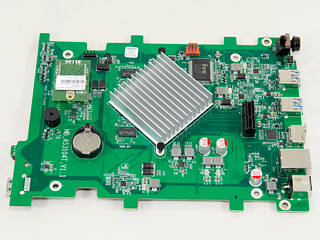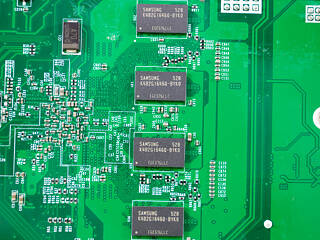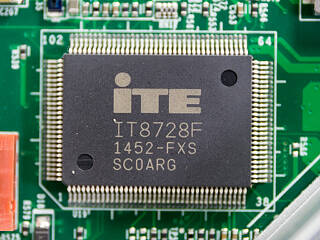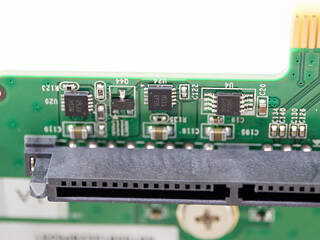 0
0
Asustor AS3102T 2-bay NAS Review
Introduction

We would like to thank Asustor for supplying the review sample.

Asustor was among the first companies to use Intel's Celeron N3050 processor for its NAS products. Currently, the AS6104T, AS6102T, AS3102T, and AS3104T use this CPU, while the higher-end AS6202T and AS6204T use Intel's stronger N3150 CPU. The N3050's and N3150's major asset is that they feature a hardware encryption engine that is compatible with Intel's new AES-NI instruction set, which will allow these to offer high speeds with encrypted-file transfers, an area where NAS servers equipped with the Intel Celeron J1900 struggle because it lacks support for the instruction set.
According to Asustor, the N3050 isn't only fast with encrypted files as it is also capable of smooth 4K multimedia playback over the NAS's HDMI port, and a NAS meant to play a major role in a home should be compatible with 4K content since 4K monitors and TVs are widely available now. The Celeron CPU's hardware transcoding engine helps with 4K and 1080p content playback, and the NAS has a decent amount of RAM for a home NAS to make sure it won't bottleneck. The AS3102T sold for almost 260 bucks at the time of review, making it one of the most affordable two-bay NAS servers equipped with an Intel CPU. After a first glance, its only downside seems to be the lack of removable HDD trays as the HDDs are directly installed internally, which makes hot-swapping them impossible unless you operate the unit without its casing. The lack of HDD trays most likely won't be a set-back for home users who will install their HDDs once, without bothering with them afterward unless more storage space is required or one dies.
Specifications
| Asustor AS3102T Specifications | |
|---|---|
| Processor | Intel Celeron (N3050 Braswell) 1.6 GHz Dual-Core Processor |
| Operating System | Embedded Linux |
| Memory | 2 GB SO-DIMM DDR3L (not expandable) |
| Storage | 2x 3.5"/2.5" SATA II/III |
| RAID Levels: | Single Disk, JBOD, RAID 0, 1 |
| Capacity | up to 16 TB (disks not included) |
| iSCSI | Target & Initiator |
| AES-NI Support | Yes |
| Networking | 1x 10/100/1000 Mbit Ethernet |
| I/O Ports | 3x USB 3.0 1x HDMI 1.4a |
| Dimensions | 165 (H) x 102 (W) x 218 (D) mm 6.5 (H) x 4.02 (W) x 8.58 (D) inch |
| Weight | 1.17 kg |
| Power Consumption | Sleep: 0.69 W In operation: 13.7 W Disk hibernation: 7.47 W (with 1x WD Red 3 TB HDD) |
| Power Supply | External, 100-240 V |
| Fan | 1x 70 mm (FD127025HB) |
| Warranty | 3 years |
| Price excluding VAT (at the time of the review) | $259 |
As has already been stated, this NAS is equipped with a Braswell N3050 CPU, a CPU with an incredibly low TDP of only 6 W and support for up to 8 GB of memory; however, the NAS also only has 2 GB of memory you cannot increase. Asustor at least used dual-channel memory for a speed boost. There is only a Gigabit Ethernet port since this is a home NAS, provided by a third party controller because the N3050 doesn't have an integrated LAN controller. The other I/O ports are an HDMI 1.4b port and three USB 3.0 ports as there is no e-SATA port, which probably won't upset most of you.
The NAS is small and weighs very little. Since its CPU only has a TDP of 6 W, Asustor says it to consume very little energy in all operational mode, which we will have to confirm with our lab-grade equipment. A 70mm YS Tech fan cools the server internally. Skipping to the most interesting parts, the warranty is longer than is the norm for this product category and the unit is quite affordably priced. We should note here that most NAS manufacturers only provide a two year warranty for even their high-end NAS servers, so it was a nice surprise to see Asustor back this mainstream model with a three year warranty instead. NAS servers are supposed to operate around the clock, so the provided warranty equals double that of other products that usually operate for only several hours a day, which is also the reason for such low warranty periods as compared to those products (e.g. memory, PSUs, etc.).
Packaging
The box is small, and although not heavy, features a plastic handle on top for easily lugging it around. At its front is a photo of the NAS, along with a pale blue frame inside of which are this product's most important technical specifications. There is also an icon inside for Asustor's three-year warranty.
Asustor shows you how to configure the NAS through a smartphone or a tablet on this side, with their AiMaster app. They also state that the creation of your own cloud is a very easy procedure with the AS3102T.
Some usage scenarios are depicted on this side of the box. The truth is that NAS servers have as of late become much more than a simple network storage space, which used to be their main and only function some years ago.
You will find a brief multilingual features description on the rear of the box.
Contents & Bundle
A "thank you" message will greet you once you flip open the top flap. The NAS and its internals are well protected by foam spacers.
A small accessories box includes a set of screws for mounting the HDDs, an Ethernet cable, a software disc, and a quick installation guide.
The power brick is by Delta Electronics, which means that it is of very good quality. Its model number is DPS-60PB, and it can provide up to 60 W of power, which is more than enough to cover the needs of this NAS.
Exterior
The front with its diamond-plate finish looks very nice and the small dimensions of this NAS will make it s great choice for use in small, tight spaces. At the front are four LED indicators and a USB 3.0 port. Strangely enough, there is no power button here since it is at the back. There are also no removable trays as the HDDs are installed internally.
At the bottom is a label with the model and serial numbers, along with the NAS server's power specifications. The MAC address of the NIC is also mentioned here.
Neither side comes with exhaust grills.
The rear contains the power button, a couple USB 3.0 ports, the reset button, which is recessed into the chassis and can only be activated with a sharp, thin object, an HDMI 1.4b port, DC input, and LAN port.
A Look Inside
It's time now to strip this NAS down to discover what components it hides inside its casing. It was very easy to crack this NAS open since I only had to remove two screws at the back. Asustor obviously made it easy to open because you have to install the HDDs into a metal cage inside the NAS.Although it was very easy to remove the plastic enclosure, it wasn't as easy to take the mainboard out of the chassis. We had to remove the metal HDD cage and metal plate that covers the mainboard.
The small mainboard is under-populated, and a pretty large area is taken up by the CPU's heatsink.
The mainboard's obverse side only holds the memory modules, which are soldered into place, and a small number of ICs.
Eight Samsung K4B2G1646Q-BYK0 modules are soldered to the front and rear of the mainboard.
The UEFI BIOS is provided by Insyde Software.
The NAS uses an Intel N3050 dual-core Celeron processor with 2MB of cache. The CPU boosts up to 2.16 GHz, is compatible with Intel's Virtualization Technology, and supports the AES-NI instructions set, which its predecessor, the J1900, didn't support. This CPU belongs to the Braswell family, Bay Trail's successor. The N3050 includes a DirectX 11.2 compatible GPU, a DDR3L controller that supports up to 8 GB of memory, and is manufactured on a 14 nanometer lithography process. With a TDP of only 6 W, it doesn't require active cooling.
The CPU is powered by a 2-phase buck regulator, and the filtering caps are by CapXon.
A Texas Instruments SN75DP139 controller provides compatibility with the HDMI 1.4b standard. To put it simply, this IC takes the DisplayPort's input signal and transforms into an HDMI output signal with support for up to 4K resolutions and 3D content.
The monitoring IC is an ITE IT8728F.
The single Gigabit Ethernet port is controlled by a Broadcom BCM57781 IC.
There is a Macronix MX25U6435F Serial Flash module.
The SATA expansion card occupies the mainboard's only PCIe slot.
Here is the small PCIe expansion card that hosts both SATA connectors.
The NAS server's flash memory is by ADATA.
The fan is by YS Tech, and its model number is FD127025HB (70 mm, 12V, 5000 RPM, 40.5 CFM, 41 dBA). The manufacturer states that this fan uses double ball-bearings and has a lifetime of up to 75,000 hours.
Initial Setup & Asustor Data Master
You will initially have to put the provided software disc into a client PC's drive, after installing the NAS server's HDDs and connecting all the cables, power and network. We strongly advice you to also take a look at the Quick Start Guide. You will find the User's Guide on the bundled disc should you require some more information that cannot be found in Asustor's Quick Start Guide. Asustor also includes all compatible mobile apps on the disc should you not want to download them.
Some screenshots of the Quick Installation Guide you can find as a PDF file on the bundled software disc.
Asustor's Control Center is an essential application since it will not only find the NAS on your network, but will allow for its effortless and quick configuration. It supports many languages, including English and Chinese.
You will easily initialize the NAS through Web Setup, found inside Asustor's Control Center. The first step prompts you to pick between a 1-click setup or custom option. The latter option, which we picked, is for more experienced users.
The Setup Guide's next steps will prompt you to enter the server's name and set a new admin password. You can configure all time- and date options and set all network settings afterward. You will also have to pick between automatically or manually setting the IP address; we recommend using the latter option.
You can pick the RAID configuration that best suits your needs during initialization. Only two RAID levels are available since this is a two-bay NAS, but you can also configure your disks in JBOD (Just a Bunch of Disks) or run everything off a single disk if you cannot afford two HDDs. After all is finished and done, you will have to wait for the NAS to apply all these settings you picked before registering your product to obtain an Asustor ID, which you will need if you want to use Asustor's Application Center.
ADM (ASUSTOR Data Master) Operating System
Once initialization has finished, you will be redirected to the login page of the ADM OS administration interface.
Two notifications about a firmware and a BIOS upgrade were waiting for us right after we logged into ADM for the first time. We proceeded with both upgrades, which went smoothly.
A welcome message will greet you in ADM, offering you a tour of the web interface. We strongly advise you to follow through on this guide at least once since it will show you all the basic steps you need to take to correctly set the NAS up. The paragraphs below will also take you through those steps since we took the tour.
The ASUSTOR Data Master Operating System, ADM for short, is a Linux-based operating system Asustor developed exclusively for their NAS servers. Although the development cycle was significantly shorter than with QNAP's and Synology's offerings, ADM is still capable, managing to compete with QTS and DSM in terms of reliability, functionality, and usability. ADM comes with all the features and options one would expect to find in an OS for such a modern NAS, and Asustor provides frequent OS updates that fix problems or add new features.
Some of ADM's interesting features include the Searchlight search engine, ability to pin frequently used applications to the menu bar, customizable desktop wallpapers, two-way transfer support, Mission Mode backup, FTP Explorer, or KODI (formerly XBMC) player support, under others. The only serious omissions are the fact that you cannot re-size windows and the lack of widgets, which both Qnap's and Synology's operating systems include. We highlighted both of these omissions in our previous Asustor product reviews, but the current version of ADM unfortunately still doesn't include either.
Right next to the search option are the administrative options with which you can shutdown, reset, or put the NAS to sleep, in the desktop's top-right corner.
These settings allow you to change the admin password, ADM's language setting, or the administrator's email address. You can also optimize your wallpaper here.
Our Patreon Silver Supporters can read articles in single-page format.
Apr 19th, 2024 23:30 EDT
change timezone
Latest GPU Drivers
New Forum Posts
- I just succesfully baked DDR4 (75)
- GPU-Z reporting wrong ReBar info for RTX 20 series (4)
- I9 13890HX undervolting Suggestions (5)
- Official Board Game Discussion (4)
- Roccat Kone AIMO has developed a double left click, when I click it once. Any fix out there? (37)
- Cinebench crashed my PC. My Wi-Fi stopped working, and I keep getting a "Please wait" screen when I boot up my PC. (8)
- USB C to USB A hub (43)
- XFX RX580 stock Bios (8)
- Your PC ATM (34488)
- 2 questions about Oculus Quest 3 (0)
Popular Reviews
- Horizon Forbidden West Performance Benchmark Review - 30 GPUs Tested
- Fractal Design Terra Review
- Corsair 2000D Airflow Review
- Thermalright Phantom Spirit 120 EVO Review
- Minisforum EliteMini UM780 XTX (AMD Ryzen 7 7840HS) Review
- Creative Pebble X Plus Review
- FiiO KB3 HiFi Mechanical Keyboard Review - Integrated DAC/Amp!
- ASUS GeForce RTX 4090 STRIX OC Review
- NVIDIA GeForce RTX 4090 Founders Edition Review - Impressive Performance
- ASUS GeForce RTX 4090 Matrix Platinum Review - The RTX 4090 Ti
Controversial News Posts
- Sony PlayStation 5 Pro Specifications Confirmed, Console Arrives Before Holidays (111)
- NVIDIA Points Intel Raptor Lake CPU Users to Get Help from Intel Amid System Instability Issues (102)
- US Government Wants Nuclear Plants to Offload AI Data Center Expansion (98)
- AMD "Strix Halo" Zen 5 Mobile Processor Pictured: Chiplet-based, Uses 256-bit LPDDR5X (84)
- Windows 10 Security Updates to Cost $61 After 2025, $427 by 2028 (82)
- Developers of Outpost Infinity Siege Recommend Underclocking i9-13900K and i9-14900K for Stability on Machines with RTX 4090 (82)
- TechPowerUp Hiring: Reviewers Wanted for Motherboards, Laptops, Gaming Handhelds and Prebuilt Desktops (73)
- Intel Realizes the Only Way to Save x86 is to Democratize it, Reopens x86 IP Licensing (70)




































































































